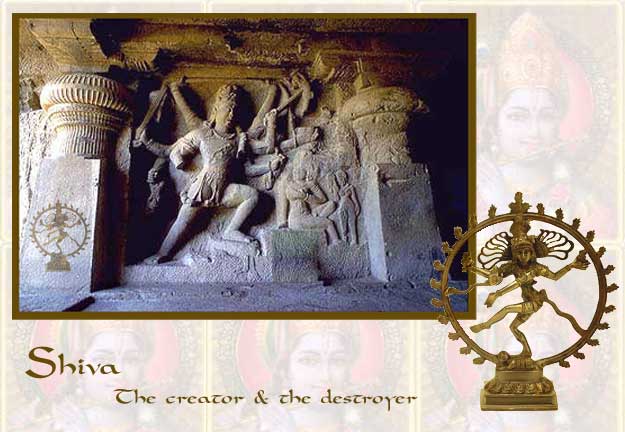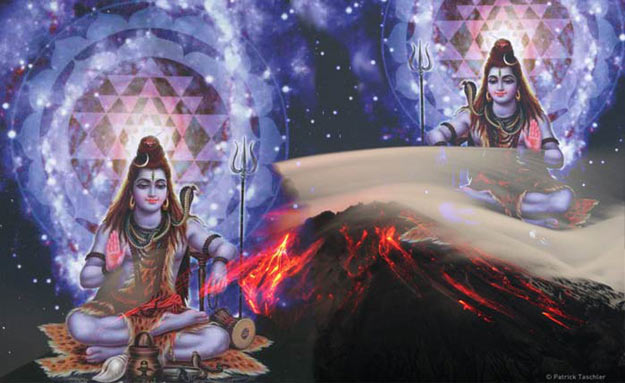Buddhism and Hinduism have a common past, and while there are many
similar beliefs between the two religions, there are just as many
differences between the Buddhist and Hindu religions.
REBIRTH, REINCARNATION, SAMSARA
Both Buddhism and Hinduism believe in an (almost) endless cycle of births, known as samsara. They also both seek release from this cycle of rebirths.
Hindus believe in an everlasting soul (atman) that is reincarnated more-or-less intact from birth to birth. Through spiritual practice, Hindus seek release (moksha, also known as liberation) so that the soul can join with the Universal Divine Force (Brahman, often simply translated as God).
The Buddha, however, taught that there wasn’t a constant soul, but a collection of feelings, perceptions, senses, and other intangibles that made up all living beings. The concept of the lack of a constant sould is known as anatta.
Hence, for Buddhists, the ultimate goal is something more abstract: ending suffering by escaping the cycle of rebirths, and entering into a state of Nirvana. It is a common misconception to translate Nirvana as meaning “Paradise,” or as “Heaven.” Nirvana itself is something of an abstract concept. One meaning is “cool,” which implies that one is far away from the fires of desire and Kilesa (defilement).
KARMA: CAUSE AND EFFECT
Both Buddhism and Hinduism believe in the concept of Karma, which states that our past actions affect our present and future life states. One could do evil in this life and be reborn a worm in the next life. Similarly, afflictions in this life are often explained away as the effects of Karma from a previous life (or from misdeeds earlier in this life).
DHARMA: THE WAY OF LIFE
The word Dharma is common to both Buddhist and Hindu religions. Buddhists generally use the word Dharma to refer to the collective teachings of the Buddha, and the Buddha used the word Dharma to roughly mean “how the universe works.”
The Hindu concept of Dharma might be thought of as being “one’s role in the universe.” The concept includes not only one’s performance of religious acts, but how they act in society and how they act toward their family responsibilities.
In Hindu society, one’s dharma may vary depending upon their caste, and in what stage of life they are in. An older man from a higher caste might have a different dharma than a young man from a lower caste.
DEVOTION TO GOD
Hinduism, which has thousands of gods and goddesses, is for the most part actually a monotheistic religion. Each god is seen as one manifestation of the one Supreme God.
In Hinduism, each family will be devoted to a particular deity. Most Hindus practice devotion (bhakti) to either a form of Lord Vishnu or Lord Shiva. They see this as one essential part of religious practice.
The Buddha, on the other hand, taught that we should not concern ourselves with worship or devotion to a particular God. The Buddha did not deny the existence of a Supreme God: he just said that we are responsible for our on enlightenment, and not to believe that a supreme being could help us.
The Buddha did decry the practice of animal sacrifices in devotional acts to the gods and goddesses that were commonplace. Eventually, this belief in the sacredness of all life spread to Hinduism, and animal sacrifice became the exception instead of the norm. In fact, the Buddha’s impact on Hinduism was so strong that followers of Vishnu believe that the Buddha was one of Vishnu’s avatars (a being that helps humanity in times of distress). Buddhists do not share this belief.
MEDITATION AND YOGA
Both Buddhism and Hinduism believe strongly in developing awareness and mental concentration in the spiritual quest. In Buddhism, meditation is near ubiquitous, with insight meditation (Vipassana) being the most emphasized form of meditation. Buddhist monks are expected to spend hours each day in meditation, while the lay people are expected to practice regularly, and are free to attend meditation sessions at local temples. The Mahayana Schools of Buddhism also emphasize Metta (compassion) meditation.
In Hinduism, Yoga is more than a series of postures to be held as a form of exercise. Instead, Yoga (which literally means Yoke, as in to be yoked to God), consists of 8 different practices as follow:
Abstention from sins such as theft, violence, sex, greed, dishonesty
Observance of self and tolerance
Postures (known as Asana), which are familiar to most Westerners
Breath Control
Withdrawal of senses
Mental concentration and stilling the mind
Meditation
Contemplation
REBIRTH, REINCARNATION, SAMSARA
Both Buddhism and Hinduism believe in an (almost) endless cycle of births, known as samsara. They also both seek release from this cycle of rebirths.
Hindus believe in an everlasting soul (atman) that is reincarnated more-or-less intact from birth to birth. Through spiritual practice, Hindus seek release (moksha, also known as liberation) so that the soul can join with the Universal Divine Force (Brahman, often simply translated as God).
The Buddha, however, taught that there wasn’t a constant soul, but a collection of feelings, perceptions, senses, and other intangibles that made up all living beings. The concept of the lack of a constant sould is known as anatta.
Hence, for Buddhists, the ultimate goal is something more abstract: ending suffering by escaping the cycle of rebirths, and entering into a state of Nirvana. It is a common misconception to translate Nirvana as meaning “Paradise,” or as “Heaven.” Nirvana itself is something of an abstract concept. One meaning is “cool,” which implies that one is far away from the fires of desire and Kilesa (defilement).
KARMA: CAUSE AND EFFECT
Both Buddhism and Hinduism believe in the concept of Karma, which states that our past actions affect our present and future life states. One could do evil in this life and be reborn a worm in the next life. Similarly, afflictions in this life are often explained away as the effects of Karma from a previous life (or from misdeeds earlier in this life).
DHARMA: THE WAY OF LIFE
The word Dharma is common to both Buddhist and Hindu religions. Buddhists generally use the word Dharma to refer to the collective teachings of the Buddha, and the Buddha used the word Dharma to roughly mean “how the universe works.”
The Hindu concept of Dharma might be thought of as being “one’s role in the universe.” The concept includes not only one’s performance of religious acts, but how they act in society and how they act toward their family responsibilities.
In Hindu society, one’s dharma may vary depending upon their caste, and in what stage of life they are in. An older man from a higher caste might have a different dharma than a young man from a lower caste.
DEVOTION TO GOD
Hinduism, which has thousands of gods and goddesses, is for the most part actually a monotheistic religion. Each god is seen as one manifestation of the one Supreme God.
In Hinduism, each family will be devoted to a particular deity. Most Hindus practice devotion (bhakti) to either a form of Lord Vishnu or Lord Shiva. They see this as one essential part of religious practice.
The Buddha, on the other hand, taught that we should not concern ourselves with worship or devotion to a particular God. The Buddha did not deny the existence of a Supreme God: he just said that we are responsible for our on enlightenment, and not to believe that a supreme being could help us.
The Buddha did decry the practice of animal sacrifices in devotional acts to the gods and goddesses that were commonplace. Eventually, this belief in the sacredness of all life spread to Hinduism, and animal sacrifice became the exception instead of the norm. In fact, the Buddha’s impact on Hinduism was so strong that followers of Vishnu believe that the Buddha was one of Vishnu’s avatars (a being that helps humanity in times of distress). Buddhists do not share this belief.
MEDITATION AND YOGA
Both Buddhism and Hinduism believe strongly in developing awareness and mental concentration in the spiritual quest. In Buddhism, meditation is near ubiquitous, with insight meditation (Vipassana) being the most emphasized form of meditation. Buddhist monks are expected to spend hours each day in meditation, while the lay people are expected to practice regularly, and are free to attend meditation sessions at local temples. The Mahayana Schools of Buddhism also emphasize Metta (compassion) meditation.
In Hinduism, Yoga is more than a series of postures to be held as a form of exercise. Instead, Yoga (which literally means Yoke, as in to be yoked to God), consists of 8 different practices as follow:
Abstention from sins such as theft, violence, sex, greed, dishonesty
Observance of self and tolerance
Postures (known as Asana), which are familiar to most Westerners
Breath Control
Withdrawal of senses
Mental concentration and stilling the mind
Meditation
Contemplation






